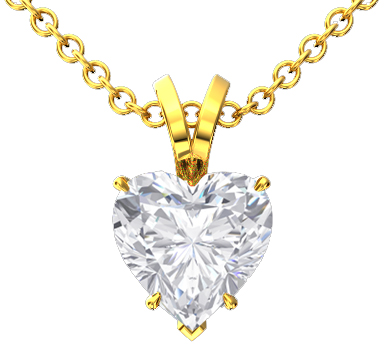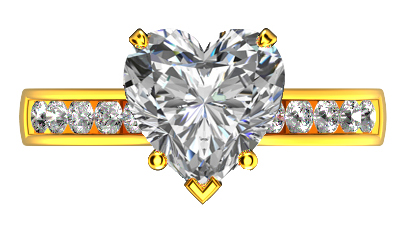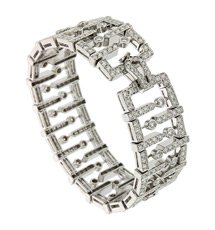Heart shaped diamonds are thought to be the most romantic shapes of diamonds. They are mostly seen in solitaire pendants, but are just as mesmerizing when set in an engagement ring. This shape is said to be one of the most difficult cut for a diamond. It is strongly recommended to check the length to width ratio before making your choice, to help determine whether the heart shaped diamond is short, fat, narrow or evenly proportioned. If you are looking for a stone for your heart shaped diamond ring, a slightly wider cut will look better than a narrow cut. Consider looking for a heart shaped diamond with a high cut grade. Color varies just like with any other fancy shaped diamond, and this is mostly a matter of preference whether you would like a warmer color or a colorless stone.
The Complexity of Heart Shapes
 One of the most elaborate of fancy diamond cuts, the heart shape is a testament to skill. Not only must there be an outline of a heart, but it must also shine like to the best of its ability. The popularity of heart jewels means that many are made, and each one needs to look just right.
One of the most elaborate of fancy diamond cuts, the heart shape is a testament to skill. Not only must there be an outline of a heart, but it must also shine like to the best of its ability. The popularity of heart jewels means that many are made, and each one needs to look just right.
Due to its role in circulating blood, hearts are associated with life. Ancient Chinese, Egyptian and Greek scholars believed this vital part of the body to be the center of thought and emotion. Over time, the heart grew increasingly connected with love and romance. The stylized symbol that we know today originated in medieval Europe, making its debut in illustrations of courtly romance.
The parts that make up a heart shaped diamond are the lobes, wings, cleft, belly and point. Lobes are the curves that form the top of the heart, while the cleft is the gap that separates the two. The belly makes up the widest and roundest part of the jewel, tapering down into the bottom tip of the stone, known as the point. Wings fill in the space between the point and belly. Each portion must be in balance with the rest for the heart to look attractive. The overall shape should be proportional, as should the facets which determine sparkle and outline. Symmetry and ratio help with making sure the heart is formed as it should be by providing guidelines for diamond cutters. Precise calculations, a keen eye and steady hands are essential to making a quality heart shape diamond.
Popular legend calls hearts the source of love and emotion. Heart shaped diamonds take a great amount of skill to produce, making them all the more precious. The meaning behind the symbol, along with the care taken in the jewel’s creation, combine to make a fancy shape rich in romance.
Hearts and Love
Hearts have been celebrated for centuries as a symbol of romantic love. The tips of Cupid’s arrows were once painted as heart shaped, Valentine’s Day is filled with heart imagery and wedding rings are worn on a finger believed to have a vein that runs directly to the heart. Gifts, particularly those associated with weddings, engagements and other occasions of love may use heart shaped loose diamonds to underscore emotion and sentiment.
The anatomy of a heart shaped diamond is complex. The top is flanked by two curves known as lobes, in between them is a dip called the cleft. On the other side of the jewel opposite the lobes is the point, which is flanked by wings. Between the wings and the lobe is the belly. For heart shaped diamonds to be aesthetically pleasing, their elements should be in balance with one another. The lobes should be of the same size and curve, as should the wings. Asymmetry may hinder the diamond’s brilliance. The stone’s length to width ratio should be between 1:1 and 1:1.2, and its tip should be defined rather than blunted.
Heart diamonds may have girdles that vary in thickness along their perimeter. The diamonds should be carefully mounted to discourage chipping along its thinner edges. Likewise, tips should be kept in a V shaped for protection. With these precautions in place, heart shaped diamonds will look and remain wonderful, whether its mounted in a pendant, brooch or heart engagement ring.
Diamonds and Hearts
Hearts, the shape of an inverted triangle with two curves on its top, is a traditional symbol of love and romance. Diamonds, particularly diamond engagement rings, are used to signify love and a steadfast bond. Heart engagement rings combine both symbols, portraying love in both shape and substance. The most common style are diamond engagement rings with heart shaped stones, though they are just one of several options.
 Fancy cut diamonds faceted into the shape of a heart are popular tokens of love and romance, which takes great skill to produce. Unlike princess cut diamonds or round brilliant cut diamonds, the shape of heart diamonds is more variable, with lobes, wings, a cleft and point. All of these elements must be in balance with one another, as well as be faceted to provide brilliance and fire. Setting these diamond rings in a way that protects the jewel while displaying it to be its brightest highlights yet more craftsmanship.
Fancy cut diamonds faceted into the shape of a heart are popular tokens of love and romance, which takes great skill to produce. Unlike princess cut diamonds or round brilliant cut diamonds, the shape of heart diamonds is more variable, with lobes, wings, a cleft and point. All of these elements must be in balance with one another, as well as be faceted to provide brilliance and fire. Setting these diamond rings in a way that protects the jewel while displaying it to be its brightest highlights yet more craftsmanship.
Other hearts may appear on diamonds by happy coincidence. Clarity is the presence or absence of quirk on or inside a diamond that may influence its brilliance and overall aesthetic appeal. Gemologists and connoisseurs usually aim for jewels that have few clarity characteristics, or ones whose quirks are visible only under magnification. Every so often, clarity characteristics resemble a heart, such as a series of pinpoints that form the romantic shape.
One colorful clarity characteristic is displayed on the top facet of the two carat round brilliant Forsythe Diamond. Crystals within crystals are a common quirk in jewels. What makes the Forsy the Diamond stand out is its 140-micron heart shaped garnet. As suits its romantic imagery, the diamond was auctioned on Valentine’s Day 2016, with the proceeds going to charity.





